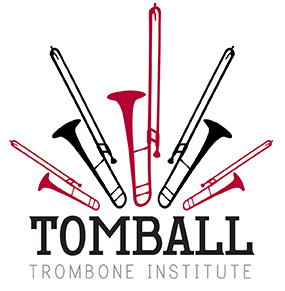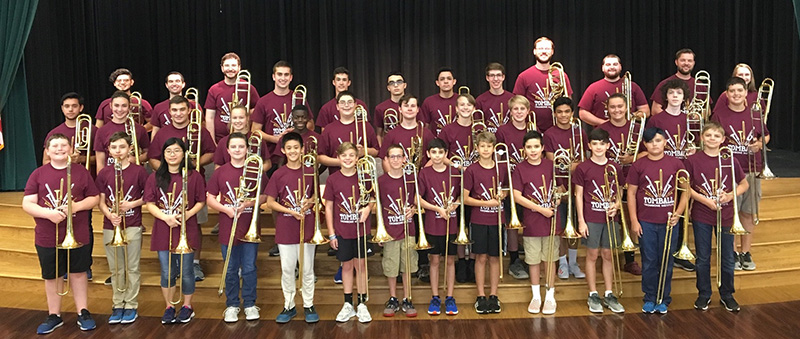Creating Opportunities for Young Trombonists
 This article was written in collaboration with Matthew Halbert and Ben David Aronson, who co-founded the Tomball Trombone Institute with Dunn. Aronson teaches and performs across western New York, and is a founding member of Incantare. Halbert is the bass trombonist with the Des Moines Symphony and teaches at Drake University and Grinnell College.
This article was written in collaboration with Matthew Halbert and Ben David Aronson, who co-founded the Tomball Trombone Institute with Dunn. Aronson teaches and performs across western New York, and is a founding member of Incantare. Halbert is the bass trombonist with the Des Moines Symphony and teaches at Drake University and Grinnell College.
Introduction
We founded the Tomball Trombone Institute to create an opportunity for students and for the greater trombone community. Since then, our annual program has seen increased enrollment, additional divisions added, and provided an opportunity for trombonists to teach others and perform. We strongly believe in the educational experience we provide to our students, as well as the professional benefit we can provide to trombonists, including ourselves. It is our hope that by sharing our story, we can inspire others to create opportunities in their communities to further our instrument and education.
Forming the Idea
Jeff joined the Tomball Independent School District staff as a Private Instructor in 2014, where he gave private lessons to low brass students in grades 6 through 12. As a full time educator, Jeff had the desire to start, and teach at, a summer program for the local trombonists. Planning began in the summer of 2016, with the goal of an inaugural program in 2017. The Institute's focus was junior high level students: those having completed sixth, seventh, or eighth grade during the 2016-2017 school year.
This age group presented itself as a possible market that was not tapped yet, based on Jeff's previous masterclass experience. In the fall of 2015, Jeff hosted two Region Band clinics: the first, for students in 7th and 8th grade, was well attended by many local students, while the second, for high school students, was not nearly as successful. The need for quality instruction and opportunity for younger students was apparent, as there were few programs that catered to their needs.
After creating a proposal for the week's activities and a rough budget, Jeff suggested the idea to those involved: the campus band director who would host, as well as Ben David and Matt who would join as the other faculty members. After this approval, Jeff met with the district Director of Fine Arts to gain insight on taking the right steps to set it up, as well as the building principal to sign off on hosting the Institute. Having the correct support in place before officially booking the rooms was a necessary step towards ensuring success. The first attempt to put the event on the school district calendar failed, however; the rooms could not be reserved by the school band program, but rather only registered 501(c)3 non-profit organizations. Fortunately, the local band parent group had the necessary classification, documents, and support to take on our program, and our second attempt proved more successful.
Advertising
To make the program viable, we promote to students and parents through flyers, emails, and social media. While the flyers catch students' attention at school, they often do not make it back to the parents. Targeted emails to parents and band directors proves much more effective, as links to the website and registration information often results in students signing up, or responses with questions. Sharing the information with local band directors also helps encourage them to speak with their students, and forward the promotional email to their students.
On social media, we use Facebook, Instagram, and Twitter. While we technically reach the most people through Instagram (according to the number of followers), the most effective means of social media connectivity is Facebook. Facebook has been a source of communication with parents, through its messenger feature, where they have reached out to ask specific questions about the program. It is possible that the parents of the kids we are reaching are more accustomed to the older Facebook platform, rather than the newer Instagram and Twitter. Consistent posting on a weekly basis is important in keeping our followers engaged; the goal in this process seems to be the toeing of the line between being visible and oversaturation of posts to the individuals we wish to reach. This holds true for any individual or group seeking to raise awareness for their entity.

Program Content
Once students were enrolled, we were tasked with designing the program content. Various factors influenced our approach to devising content for the Institute. The basic guiding principle for us was to introduce and emphasize concepts that we wished had been conveyed more rigorously in our own early training. Each day contains a group warm up session, faculty masterclass, a faculty recital, as well as small ensemble and large trombone choir rehearsals. This primary content is all geared toward individual development, and preparing for the final concert at the end of the week. Additional masterclasses by guest artists occur throughout the week, as well as special topic classes lead by faculty. Previous topics have included jazz improvisation, the trombone in unique ensembles, instrument maintenance and repair, and health and wellness. Through these wide range of performing opportunities not typically available in traditional band programs, students play all day in a learning environment that allows them to try new things.
With such a packed schedule, our Institute hires two to three interns annually to support our program. These are always undergraduate music students, often pursuing a Bachelor's Degree in Music Education. While our interns do much of the behind the scenes work, such as ensuring that our rooms are set properly, tables are ready for lunch, and welcoming and dismissing our participants each day, their prime opportunity is to assist with chamber music coaching of our participants. The experience of working with students is one many seek as they become professional educators, and it gives the Institute the necessary staff for a low student-teacher ratio. By offering a small stipend for their work, we are able to recruit high quality interns from strong collegiate programs in our area.
Budgeting
Ensuring financial stability is essential for any program to flourish, and our budget model relies on keeping the cost low enough for many students to enroll. We aimed to undercut other local programs on cost, and offer more value in a full five day week. All of our funding comes from participant tuition, and about 80% is allocated to faculty and staff fees. Our next largest allocation, about 13%, goes to food, to provide lunch each day for all participants and staff. Lastly, the remaining 7% of the budget is allocated for the annual program T-Shirts, as well as any other incidental supplies needed for our classes. Each year, we can estimate a target for enrollment, but the budget must remain flexible, as the amount of tuition income can only be an estimate.
Looking to the Future
As the Tomball Trombone Institute continues to grow, we are forming a new 501(c)3 organization to manage our institute, assist with other relevant events, and expand our offerings. As new trombonists join our team, we aim to reach a more diverse population of students, provide more resources to educators of our instrument, and ensure that professionals have an outlet to share their teachings and performances with the next generation.
We hope that our story of founding the Tomball Trombone Institute can provide some insight into creating opportunities for other musicians, and would be glad to talk to anyone who might have questions about the process. Please look for us on Facebook and Instagram, and visit us on the web. Feel free to contact any of the three authors via the contact form, and keep an eye out on the Online Trombone Journal for an upcoming article with resources for creating new opportunities for musicians.
